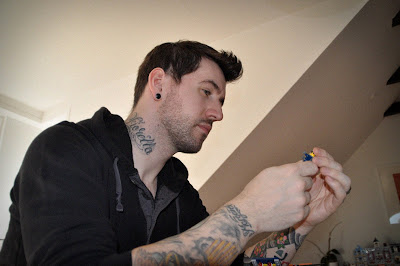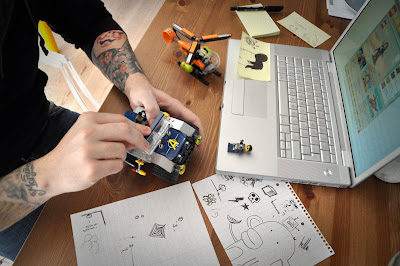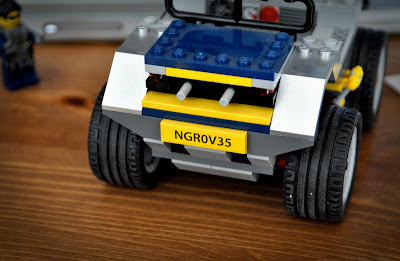 Hey everyone, I'm really excited to bring this interview to you because I for one grew up playing with LEGO for hours on end. Nicholas talks about some really cool stuff and is very insightful so please take the time to read the whole interview especially if you love LEGO! And once you're done feel free to check out his Coroflot for more of his work.1. You seem to love what you do; can you remember when you were bitten by the LEGO bug?
Hey everyone, I'm really excited to bring this interview to you because I for one grew up playing with LEGO for hours on end. Nicholas talks about some really cool stuff and is very insightful so please take the time to read the whole interview especially if you love LEGO! And once you're done feel free to check out his Coroflot for more of his work.1. You seem to love what you do; can you remember when you were bitten by the LEGO bug?I guess, like most people, it started when I was a young boy. I think I was around 4 or 5 when I first starting playing and building with LEGO. I have an older brother, so most of my LEGO was passed down to me from him, and to be honest it was many years before I realized that LEGO actually came in sets. I just assumed it came to your house in a big Tupperware box! Me and my brother would build lots of spaceships then have a massive intergalactic space battle! This would normally end up in a BIG mess much to our poor mother's dismay.
However, once I got a little older it was decided I was too old for LEGO and it was all passed onto my younger sister and then to my younger cousins. So I didn't really touch LEGO again until they approached me about work - I was going through what the Adult LEGO fans call 'my dark age'. That's the dark, sad period in your life when you have stopped playing with LEGO before you rediscover it again. One part of me wishes I still had my old LEGO stashed away in the attic, but alas, I have no idea where it is now. However that's one of the things that makes LEGO different from most other toys. The LEGO that my family and I played with is probably still being enjoyed by some kid I'll never even meet. It's very rare that LEGO goes in the trash, unlike many other toys it takes on a life of its own and jumps from child to child, which is amazing.
2. LEGO pieces connect and build upon each other, how do you think designing a LEGO toy differs from tradition toy/product design?Hugely. In most toy/traditional design, you can sit down, sketch out an idea, make a mock-up, put it into CAD, have a mold made and stick the product in a box (that's obviously the VERY short version!). We can't do that. With LEGO, you are working with a 'system', and that changes the design process a lot. Not only do we have to come up with cool ideas for vehicles, buildings, functions, characters and play scenarios but we then have to sit down and make it from scratch with our hands. Getting the idea from your head into brick is the main process we go through, you can't just mold up any shape or brick you want. You have to find the bricks that give you the form you want and then make sure its stable and build-able for a child. So it becomes a bit of a puzzle trying to get a great looking model that's build-able, fun to play with and on budget.
The fact we make our toys from a building system means we have to pretty much know every element and how they will work together. Becoming a LEGO designer is a bit like taking on a old fashioned apprenticeship in many ways. You work with a more experienced designer to get your building skills up to par and there is nowhere else you can learn these skills. We're the only team that do what we do and it can take a decent amount of time to be a good builder. Of course, almost anybody can go out and mold some bricks and put it into a box, but when you're working with people who have been doing it for 20+ years you know nobody out there can top them. The knowledge and the quality within the team is not something you can copy so easily and it's great to work with designers like these.
When we start sketching models after a briefing, we normally grab a big box, go to the element basement and grab handfuls of the elements we think might work and meet our needs. Then we will sit down in a group for a couple of days and build away. At this early stage we may even spray paint elements we don't have in the right colours yet and start discussing new elements and if they are needed. From this we will then pick the strongest models and functions and use those as a kick start for the project and design process. We go through many loops and variations before we get to the final model, you never get the model right the first time round.
One important stage we go through, is called 'model review', this is when I (or any other designer) will sit down with a committee consisting of: two other model designers, somebody from our building instructions team, an element engineer and somebody from global quality control. Together with my creative lead, this group will all build the model brick by brick so we can agree it is up to LEGO standards. This is a very crucial process that every LEGO model has to go through. If the team does not agree with any part of the model, it has to be addressed and shown to the team again before it can go into production. It's kind of like an exam for the designer! Plus you have to do this all from memory, not so bad if your doing a $10 set, but once you get in the $120 sets with 2000+ elements in it, then you really have to make sure you remember where every brick goes.
3. How do you approach your designs for LEGO as opposed to other products? Do you design each LEGO toy with expansion in mind (combining with other LEGO toys)?Expansion is a given when your talking about LEGO, bricks today work with bricks that were molded 40 years ago so its not something we have to worry about or factor in too much when designing. Obviously there are sets that have multiple models made from the same set of bricks and that has it own set of challenges for the designer, plus this has usually been decided at the start of the project so the designer can factor in the right amount of time. It involves extra design loops for the team, but normally we focus on making one great main model, then try to make others based on the elements available... So again, it becomes a bit of a puzzle.
When starting a model or models, we simply start with brainstorming ideas. We normally start by creating a universe where we can base our story and characters. From this, the early ideas for the sets can develop. We pick key points from our story that will allow the kids to create and act out the adventure in the world we have made for them. Once we have a good foundation, we then sketch up some ideas in bricks and start looking at what is or is not working.
4. I’ve heard that LEGO has a custom CAD program they use, is that true? If so what’s the name and where can one find it?Yes we do, its called 'Easy Builder Tool' or EBT as we call it in the office. It's an add-on to Maya that was made for us, and essentially, it has every LEGO element on file that we can import and build with. It also has extra features that only we would use, for example you can import all the 9 elements you need to make up one LEGO mini figure, then instead of assembling it yourself (which can time a lot of time) you can hit a button and EBT will piece it together for you. It's used mainly by our building instruction teams who can layout all the steps one by one and then have them rendered in hi-res. We as designers can also use it for costing and pricing of models as every element has a price, we can import all the parts and see how much it would cost. As far as I know, it's not out there for the public to use, but there is a program out there called LDraw that AFOL's (Adult Fans of LEGO) use to make renderings and do their own building instructions.
 5. Do you start each design with a sketch, jump right into CAD, or simply grab a box of LEGO and start ideating?
5. Do you start each design with a sketch, jump right into CAD, or simply grab a box of LEGO and start ideating?It depends on the model and the designer really. If I'm working on an IP like Toy Story, then we already have a lot of reference to work from and I don't really need to sketch anything up on paper. The challenge there is to get the image that you see on screen into bricks, so on one hand, that's great because you can jump right into the building. But sometimes it can be hard if the vehicle or building is made up of some crazy abstract forms. However, if I'm working on a LEGO property like Agents 2.0 then I will do a sketch or two... and I do mean a sketch! There is no need to sit there and do a detailed marker or digital rendering, you need to get into the bricks and building ASAP as there will be many build issues to solve and time is always against you. 90% of my sketch work is done on Post-It notes and bits of A4 I grabbed out of the photocopy room. I simply sketch to help get a form or iconic shape out of my head and onto paper, it just helps to scribble the idea up a little before building. I then break the drawing down into simple shapes, and with that, you start to see in your mind's eye what elements could work to give you that form. I don't use CAD at all for my LEGO work, obviously those designing new elements will use Rhino and other CAD tools but as a builder you're ready to roll as soon as you're happy to start building.
6. If you could describe the LEGO marketing stance in the industry what would it be? How do you use the brand angle to influence your designs?We have a company motto "only the best is good enough", so the design team have a lot to live up to. We really try to ensure that we offer the kids a great model that they will not only enjoy playing with but that they will also enjoy building. We have to think of the whole process from the ground up and not just them playing with the finished model. Making sure that the kids enjoy building the toy is just as important as the final model itself. We call it "Joy of Building, Pride of Creation". Ultimately you want a child to open the box, have fun building the set, have fun playing with the set and then have fun tearing it down to make something new from their own imagination.
LEGO is a very trusted global brand and we as a company do our best to live up to that. With this in mind, you can't help but let it affect your design work, knowing your product will be played with by kids almost all over the world really pushes you do something great.
7. LEGO has so many component parts yet I’m sure you still create products that need something new. How do you go about adding new pieces and how do you keep track of the thousands already in production?Actually, over the past few years we have gone though a process of streamlining the amount of elements we produce. We have been trying not to produce tons of new elements a year because that would just make us like any other toy company. So when it comes to adding new elements we have to really think about how needed it really is, possible new element go through many check points before they are given the OK.
Most new elements will got towards updating and giving the mini figures a fresh new twist. Kids and adults love the LEGO mini figure, so we try to add lots of newness and collect-ability to them. New wigs and accessories are the areas that will make a set even more appealing to kids and fans, so we try to offer something new with every set. Ultimately, we have to find the right balance, it's great to provide something new, but we don't want to produce 50 new elements just to make one model.
As for keeping track of all the elements in production, that involves lots of Excel spread sheets and big computers that makes my brain hurt. There is a huge logistical side to LEGO that's on a global scale and we have project managers within our design team who help keep track of this and ensure the elements and sets get to the right place when we need them.
8. Do you sometimes find the restriction of LEGO construction limiting when your design?There's really not much you can't do in LEGO, so I never see it as a limitation. For me, designing a LEGO set is like creating and solving a puzzle all at the same time. You know what you want to build, so you have to find the right parts that make it work. There is a lot of trial and error and sometimes that will result in me banging my head against my desk, but there are days when it flows together nicely and that's all part of the design process.
The great thing about working at LEGO is there is always somebody who will have an idea to solve your problem. If I get stuck I can talk to members of my team or go find somebody who has some expertise in that field. Sometimes if we are doing a function in a model that uses gears and cross axles, we will go have a chat with the Technic design team, so you're never far from somebody who can give you some good advice.
 9. What programs or tools could we find in your arsenal that you couldn't design without?
9. What programs or tools could we find in your arsenal that you couldn't design without?Post-It notes: I tend to do a lot of doodles and list making on these, I should probably take out stocks with these guys?!
A small pallet knife: Separating plates and bricks all day takes its toll on your hands....and teeth! A small artist knife makes life a lot easier.
My hands: Without these, I can't build, so they really are my most important tools... Maybe I should get them ensured.
10. Do you have advice for young designers wanting to break into the field? And for those already in the field what advice do you have?For the younger designers, I would say: Don't be afraid to be you. When we are looking for designers, we're not only looking for good design skills but a great personality who will bring fun and life to the team and their models. I went to a very traditional design school with a long engineering history, so some people figured I was a little odd because I liked doodling cute characters and watching cartoons.
For those of use already there, I would say: Take time out to step back and look. It's all to easy to get tunnel visioned and forget what's going on in the world around you. So don't be afraid to take the time to watch a cartoon, read a book or go to the local toy shop.
11. What other artists/designers do you look to for inspiration?Matt Groening and Pixar have a great ability to create characters and universes that we all love, and I don't think there is a piece of work they have done I don't like.
If we are talking 'classic' designers then I'd I say: Dieter Rams and Mark Newson are two of my favorites.



